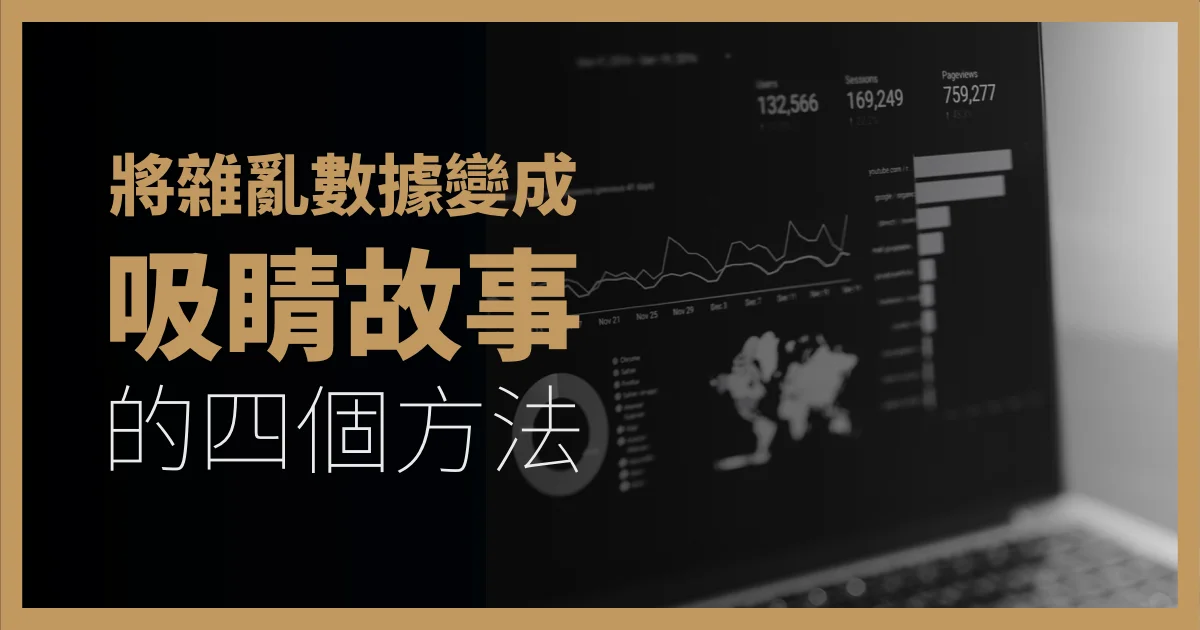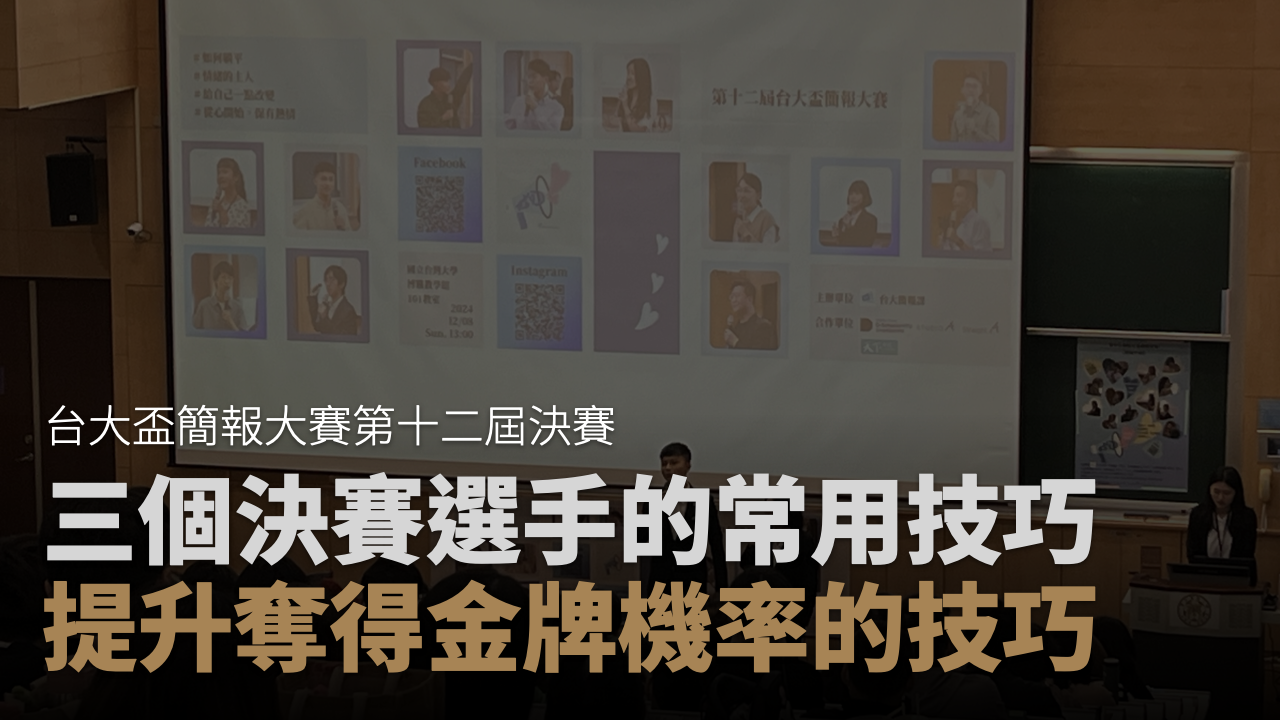將雜亂數據變成吸睛故事的四個方法
4 Ways to Turn Eye-Glazing Data Into Eye-Opening Stories
你的公司數據能告訴你許多事,然而更重要的是:它能向客戶傳達什麼?
Your company's data can tell you a lot. More important is what it can tell your customers.
假設你要向一群高中新生進行菸害防制宣導。根據相關研究,美國疾病控制與預防中心估計每 13 位青少年當中,就有一人會因吸菸相關問題而早逝。但你也知道,若沒有脈絡,單純的數字對聽眾來說毫無意義。
Let's say you're tasked with giving an anti-tobacco presentation to an audience of high school freshman. From the tobacco-related research out there, you know the Centers for Disease Control and Prevention estimates one out of every 13 teens will die early from tobacco-related problems. You also know that numbers will be meaningless without context.
如何讓這群年輕人專心聽你演講?為了強化觀點,你可以邀請其中 13 位學生上台,當這幾位學生緊張地看著彼此,每人都會默默地想:「我會不會就是那早逝的那一個?」,13這個數字頓時產生了真實的意義。
這就是「數據會說話」的力量,也是相當高明的公眾演講策略。
What do you do to engage the young people listening to your speech? You bring 13 of them onstage to illustrate the point. Suddenly, the numbers have real-world impact. As your youthful volunteers nervously look at one another, each silently wonders, "Will that one in 13 be me?"
Therein lies the power of solid data storytelling -- not to mention smart public speaking strategy.
現代的企業愈來愈容易取得大量的數據,善用數據不再是可有可無的「選修」,而是任何想保持競爭力的公司的「必修」。Future Technologies 是一家與微軟和 Tableau 合作的數據管理公司,其執行官兼主席 Asha Saxena 表示,數據是現代企業不可輕忽的環節,她表示:「每個企業都需要強大的數據策略,企業若不開始把數據視為重要資產,將會難以生存。」
Businesses have more and more data available to them, and using it is no longer optional; it's required for any company that wants to remain competitive. According to Asha Saxena, CEO and chairperson of Future Technologies, Inc., a data management firm that has partnered with Microsoft and Tableau, data is not a business element you can skip over. "Every business needs to have a strong data strategy," she says. "If they don't start looking at their data as an asset, it's going to be very difficult for them to survive."
長久以來,企業並未用明確的方式處理手中的數據。事實上,在 Experian 所提出的 2017 年全球數據管理基準報告中,超過一半的公司表示在透過數據做決策時,大多「仰賴過往經驗或直接憑直覺」。許多人就只是拋出現況,然後期望受眾可以自己得出正確的結論。毫無意外的,多數受眾在沒有任何協助的情況下無法自己理出頭緒。這時,圖表和示意圖就派上用場了。(範例:這張《華盛頓郵報》中的圖表,清楚地展示了美國人一生之中有多少年在戰爭中度過)
However, businesses historically haven't contextualized their on-hand data in a clear way. In fact, more than half of organizations included in Experian's 2017 global data management benchmark report said they "rely on educated guesses or gut feelings" when making decisions based on their company's data. Many simply push out facts, hoping audience members can draw their own correct conclusions. Not surprisingly, most people can't connect the dots without a little help. That's where charts and graphs (like this one from the Washington Post showing readers for how much of their lives the U.S. has been at war) come into play.
在現今透過數據講故事已非新的概念,人類自遠古時期就會分享故事。邁克・布羅迪, Exago 共同創辦人、三次軟體連續創業家,他解釋:「人們透過故事理解世界,我們也應該透過故事讓人們理解數據。」布羅迪認為,科技就是利用數據講故事的方法,但他也指出,僅靠科技「還無法將數據融入人類的生活背景中」。
Now, data storytelling isn't exactly a new concept. Humans have shared narratives since time immemorial. As Mike Brody, co-founder of Exago Inc. and three-time software entrepreneur, explains, "Stories are how people make sense of the world, so it follows that they'd also be our way of making sense of data." Brody sees technology as a means to facilitate storytelling with data, but points out that tech alone "cannot yet put data into human context."
光靠數據還不夠,若沒有好的說書人,數據將索然無味,亦感受不到重要性。企業不僅該挖掘出他們的數據,還要將為其代表的意義進行包裝,賦予氣味、顏色和實質的內容。
Having data isn't enough; without a storyteller, the data can seem flat or unimportant. That's why it's time for businesses to not only mine their data, but also give flavor, color, and substance to the data discoveries they unearth.
想要你的數據對受眾說話嗎?請確保你的故事結構完整、敘事合理。以下提供一些強大的說故事技巧,讓你更了解如何結合數據和商務策略:
Want your data to speak to your audience? Make sure the narrative you craft has everything it needs to tell a structurally sound story. Learn the rules for aligning your data and business strategies via these robust storytelling techniques:
一、根據聽眾調整講述故事的方式。
1. Alter your data story to fit your audience.
每位觀眾都有其獨特的需求,你的故事必須讓觀眾產生共鳴。在場觀眾都受過高等教育嗎?來自怎麼樣的社會階層?善於分析嗎?理想狀況下,要讓讀者或聽眾與你所傳遞的知識產生情感連結。好的研究論文在這點都做得很好,其篇章安排讓觀眾根據他們的需求或關注範圍,獲得精華或完整內容。同理,你的敘述方式也應該針對目標潛在客戶,以他們在乎的方式傳遞,並從個人層面激勵他們。
Every audience has unique needs, and your data storytelling must resonate with your audience's personas. Are they highly educated? Socially diverse? Extremely analytical? Ideally, you want to create an emotional link between readers or listeners and your knowledge. The best scientific research papers do this well: They have a layout that allows audiences to get both an abbreviated and full-length story depending on their needs or attention span. Likewise, you should arrange your narration in a way that matters to your target prospects and stimulates them on a personal level.
二、用角色貫穿你的故事。
2. Identify "characters" throughout your data narrative.
每個令人難忘的故事中,總會有引人注目的角色。他們可能是「好人」,也可能是「反派」。當你刻畫故事時,那個好人就是你自家公司,而那反派可能是你的競爭對手、業界狀況、或觀眾們的痛點。角色會採取行動來解決所遇到的衝突,你可以將數據巧妙融入故事中,例如將數據帶入角色的行動或行動的結果。只要是忠實呈現數據,沒有任何操縱,你可以賦予角色任何個性,讓他們為你的數據說故事。
Every unforgettable story includes compelling characters, often portrayed in "good" or "bad" lights. As you craft your story, the good guy will be your company, and the bad guy(s) could be your competitors, the conditions of your industry's market, and, of course, your audience's pain points. The characters you choose will take action to address your narrative's conflict -- their actions and the outcomes of those actions are where you can incorporate your data into the story. As long as you're being true to the data itself and not manipulating it, you can give the characters showcasing your data any personalities you want.
三、凸顯故事中的衝突
3. Highlight the conflict in your data story.
衝突讓故事更有張力,務必找出數據中的衝突點:核心問題是什麼?造成摩擦的原因?求助專業講故事者也是明智的選擇,他們能協助你為數據賦予靈魂。
你也可以與提供軟體和平台的廠商合作,一同改善陳述數據的方式,讓故事中的衝突更加突出。
Conflict makes stories more compelling, so look for the conflict point or points in your data. What's the core issue? Where are the places of friction? It may be wise to bring in a professional storyteller to help breathe life into your data. You can also team up with business intelligence vendors who offer software and platforms to foster improved data storytelling that highlights your story's conflict.
四、為故事提供解決方案和行動呼籲
4. Give your data story a resolution and call to action.
你希望受眾在聽完或看完你的故事後,得到什麼資訊或採取怎樣的行動?給他們一些指示和方向,否則他們只會得到資訊,但不會採取任何進一步的動作。舉例來說,你可能希望現有或潛在客戶購買產品、下載白皮書、加入你的郵件列表、或聯繫你公司的銷售代表等設定整體目標,並將其埋入你的故事結尾中。
After reading or hearing your data story, what should your audience know or do? Give them guidance and direction; otherwise, they'll just have the information and not take any further steps. For example, you may want customers or prospects to make a purchase, download a whitepaper, join your mailing list, or contact your sales representatives. Determine the overall goal and weave it into your story's conclusion.
現今每天都有大量數據持續增長,是時候來好好使用這些美妙的資訊了。善用這些豐富的數據,為你的觀眾帶來無窮無盡引人入勝的故事。你的團隊需要的是多一些創意,將數據視覺化並轉化成令人印象深刻的故事,而非永無止盡的商務試算表。
You're sitting on a wealth of data that keeps growing daily. It's time to use all that wonderful information to your advantage. The abundant data at your fingertips can be fuel for a practically endless supply of riveting tales for your audience. Your team simply has to become creative enough to turn it into memorable narratives and visualizations, instead of never-ending spreadsheets.
本文作者:Jeremy Goldman
本文出自:4 Ways to Turn Eye-Glazing Data Into Eye-Opening Stories
譯文出自:創譯語言顧問
責任編輯:BFA 簡報 編輯部







